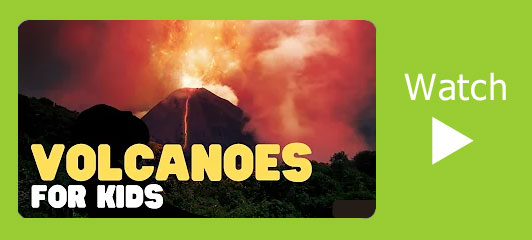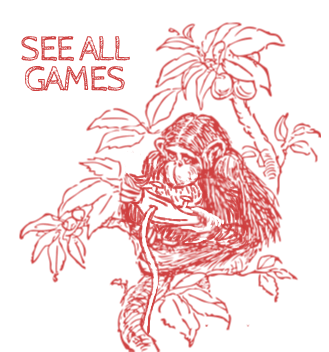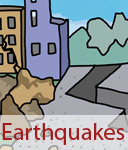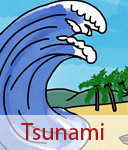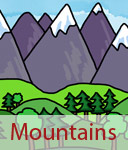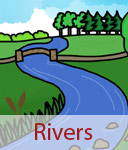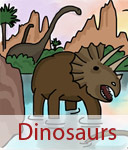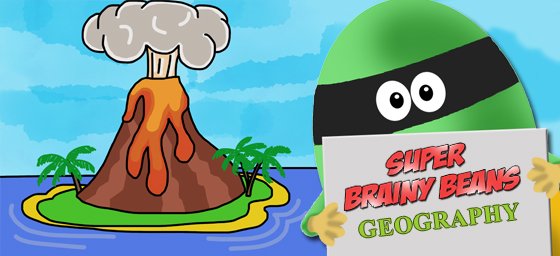
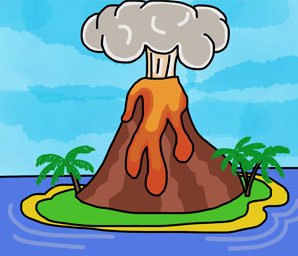
Volcanoes for kids
Volcanoes for kids learning in KS2 at Primary School. Homework help with what volcanoes are and how they are formed. Read about the impact of volcanoes on the environment.
What are volcanoes?
Volcanoes are openings in the Earth’s surface. Shaped like mountains they let out ash, gas and hot magma in sometimes violent eruptions.
 Volcanoes
VolcanoesA basic guide with pictures about Volcanoes.
How does a volcano form?
A volcano forms when two tectonic plates move apart to form a split in the earth's crust. As the plates move apart they allow the magma to come up to the earth's crust creating eruptions.
Volcanoes also appear where two tectonic plates come together. One of the plates is forced down and as it does it melts forming magma that rises through the cracks in the earth's crust.
Some volcanoes can form in the middle of a tectonic plate. Hot spots are under the earth's crust where the magma pushes through to the surface.
 CBBC Newsround - Volcanoes
CBBC Newsround - VolcanoesFascinating facts on Volcanoes. Watch the Newsround volcano film, find out how volcanic ash affects aeroplanes and volcanoes are created.
 Volcano facts and information
Volcano facts and informationA full guide to Volcanos and how they are made.
 Volcano facts
Volcano factsFind out the history of volcanoes, what they look like and the damage they cause.
What is the cause of a volcano?
Volcanos erupt when the red-hot rock called magma under the earth's crust rises up and pushes through the earth's crust. Pressure causes magma to burst out. Once the magma is out it's called lava.
 National Geographic Kids - Volcano Facts
National Geographic Kids - Volcano FactsRead facts on our explosive earth.
Which volcanoes are still active?
Volcanoes that don't erupt anymore are called extinct volcanoes. Volcanoes that erupt regularly are called active volcanoes. Some of these active volcanoes can go thousands of years before erupting again. The volcano may look extinct but in fact, it is just dormant (sleeping).
What is the Ring of Fire?
The Ring of Fire is the edge of the tectonic plate that the Pacific ocean sits on. A lot of activity around the edge of the plate. About 75% of all active volcanoes are along this edge and 90% of all earthquakes occur here as well.
How are volcanoes measured?
Volcanic eruptions can be measured using the Volcanic Explosivity Index (VEI). The table below shows the VEI scale of eruptions.
| VEI Scale | Description | Frequency |
|---|---|---|
| 0 | Nonexplosive | Daily |
| 1 | Gentle | Daily |
| 2 | Explosive | Weekly |
| 3 | Severe | Yearly |
| 4 | Cataclysmic | 10 years |
| 5 | Paroxysmal | 100 years |
| 6 | Colossal | 100 years |
| 7 | Supercolossal | 1,000 years |
| 8 | Megacolossal | 10,000 years |
Types of volcanic eruptions
There are many types of volcanic eruptions. The Hawaiian is of the most gentle eruptions. Lava is runny so it is a gentle eruption in the form of a fountain. The Plinian is the most violent eruption. Trapped gases cause massive explosions. Huge amounts of ash are thrown high into the air.
 DK Find Out - Volcanoes
DK Find Out - VolcanoesA volcano is one of the most extraordinary features on Earth, but it can also be one of the most terrifying.
 How to make a Volcano
How to make a VolcanoCreate an erupting volcano with things in your house.
Living near a volcano
It is dangerous to live near an active volcano. Volcanologists monitor volcano activity and can tell when a volcano will erupt. When hundreds of small earthquakes are detected, temperatures increase around the volcano and certain gases are released it is a good sign that the volcano is about to erupt.
People who live near the volcano can then have time to evacuate the area. This reduces the number of lives lost each year, but it's still high being around 1,000 deaths a year.
Negative and positive effects on the environment
The lava flow can create huge devastation to land. Lava can clear large areas of farmland and woodland. The natural landscapes and many homes, villages and towns are sometimes destroyed and changed completely.
The dramatic scenery that the eruptions create can attract tourists and bring money to the area.
Lava and ash provide valuable nutrients which make the soil very fertile for farming. For this reason, many people choose to live near volcanoes. The heat and activity under and around a volcano can be turned into geothermal energy which provides locals with the energy they need for their homes.
 Weather Kids - Volcanoes
Weather Kids - VolcanoesWeather Kids answers all your questions on Volcanoes.
 Homework Help - Volcanoes
Homework Help - VolcanoesFacts about Volcanoes for kids from Woodlands.
 Cool Volcano facts for kids
Cool Volcano facts for kidsVolcanoes have incredible power. Read on for some awesome facts!
 Fun Facts on Volcanoes
Fun Facts on VolcanoesOur interesting fun facts on Volcanoes will help you to learn the answers to these questions and more!
 Volcano facts for kids
Volcano facts for kidsEnjoy our awesome range of Earth facts for kids. Check out the cool trivia and have fun learning about some of our planet's most amazing features.
 Volcano Quiz
Volcano QuizFiery explosions, boiling lava, hot ash spewing everywhere. But do you know what’s really going on when a volcano erupts?
 Natural History Museum - London
Natural History Museum - LondonVisit the 'Red Zone' to see close up how volcanoes work with interactive displays and see the rocks that come from volcanoes.

